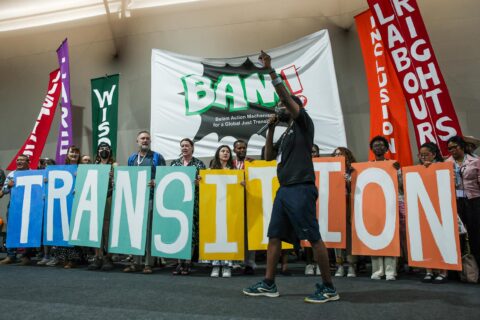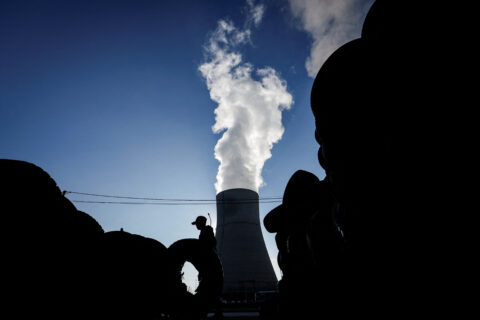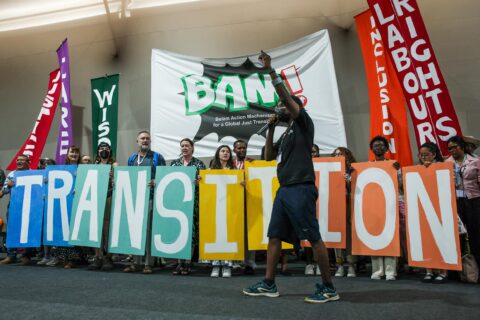This is the starting point for Europe’s lofty dreams of greener air travel – a collection point in Malaysia for greasy plastic bottles filled with discarded frying oil, thousands of miles from its final destination.
One Saturday morning last month in the city of Melaka, volunteers in green T-shirts rushed over as Adibah Rahim and her husband drove into the central square, eager to unpack, weigh and register her consignment of used cooking oil (UCO) – the “liquid gold” in European plans to ramp up production of sustainable aviation fuel (SAF).
Rahim left the collection point 90 ringgit ($21) richer, three ringgit per litre of oil – a welcome boost to her family’s household budget.
“We usually collect UCO from around 200 members of the public,” said Michael Andrew, sales manager for Evergreen Oil & Feed, the company running the Melaka collection with the local council and a supplier to leading European SAF producers including Spain’s Repsol, UK-based Shell and Finland’s Neste.
When made from waste such as UCO, rather than agricultural commodities like soy or palm oil, backers say SAF can slash planet-heating emissions by up to 80% over kerosene jet fuel, without taking up land that would otherwise be used for food crops, or fuelling forest destruction.
But behind SAF’s climate-friendly facade, a months-long investigation by Climate Home News and its partner The Straits Times has uncovered an opaque global supply chain that exposes jet fuel providers and their aviation clients to significant fraud risks, raising doubts about the climate benefits of the sector’s main green hope for the years ahead.
As SAF producers scramble for limited raw materials to meet new blending quotas in Europe and growing demand elsewhere, barely used and virgin palm oil is being passed off as UCO to traders that supply fuel companies, experts and industry operators told us. Palm oil that is not considered waste is not permitted under European Union rules for SAF because of its links to deforestation.
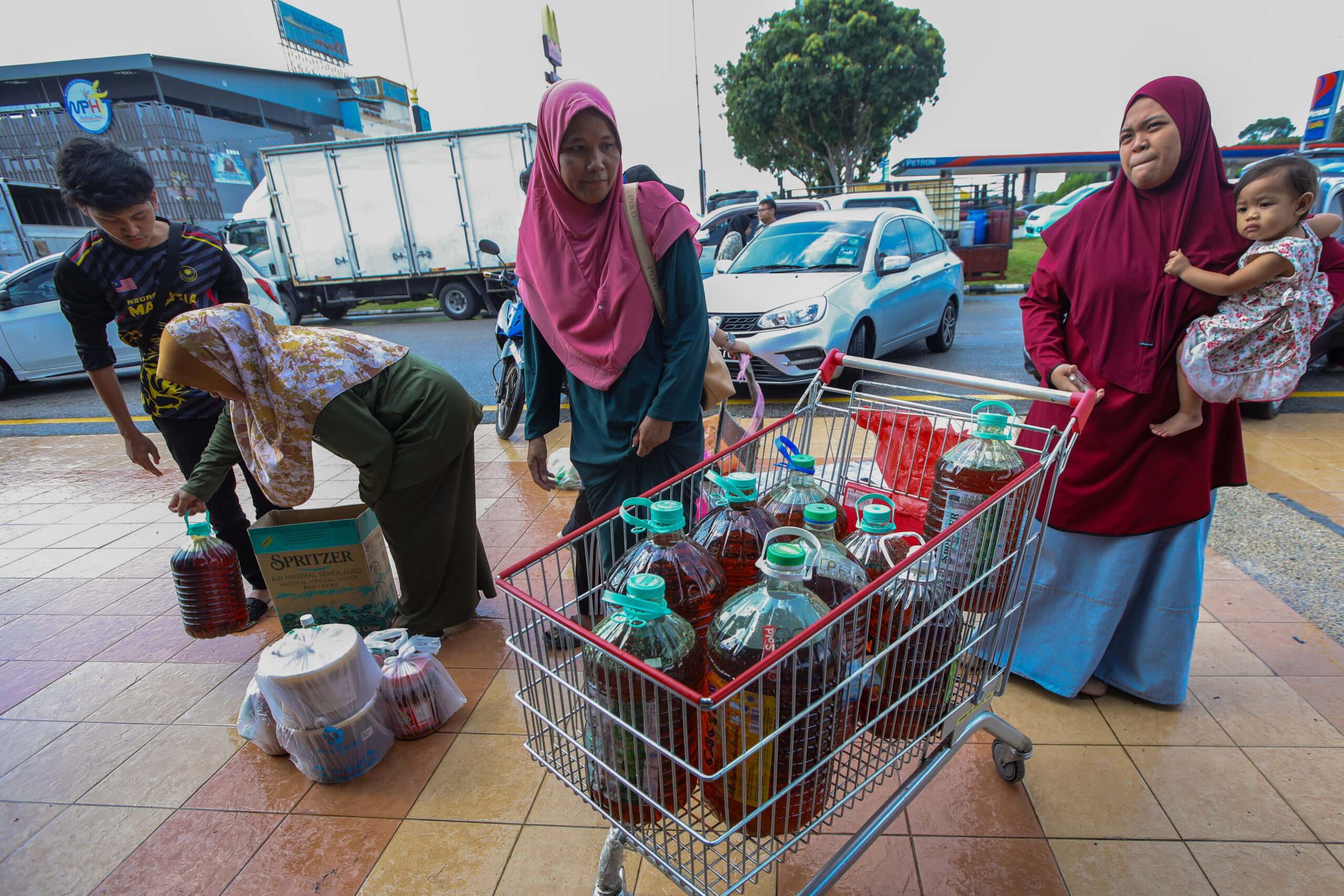

Our reporting focused on the UCO trade between Malaysia, the world’s second-biggest palm oil producer, and Spain, the EU’s largest aviation market and home to one of its SAF pioneers – oil-and-gas giant Repsol.
Fried in Spain?
Speaking at the World Economic Forum in Davos in January, Repsol CEO Josu Jon Imaz held up his company’s new 250-million-euro ($285 million) plant for renewable fuels, including SAF, near the historic Spanish port town of Cartagena as an example of how Europe can pursue a fair, green transition. Nearly half of the plant’s cost was financed by the EU’s lending arm, the European Investment Bank.
Repsol, which aims to reach net-zero emissions by 2050, started large-scale production of biodiesel and jet fuel – with its SAF mainly made from UCO – at the plant early last year.
Contrasting this with electric vehicles, many of them imported from China, Imaz said the raw material for Repsol’s renewable fuels “comes from Spanish farms and from the Spanish rural economy”.
In a promotional video for those fuels, Spanish celebrity chef Susi Díaz is seen dispensing advice to young cooks in the kitchen of her La Finca restaurant. Olive oil is then poured out of a pan into steel jugs as a voiceover explains how the waste cooking residue will be sent to the Repsol biofuels refinery.
Spain’s restaurants, however, are not the main source of Repsol’s UCO.
In 2024, more than 126,000 tonnes of UCO from Asia – enough to fill 50 Olympic-sized swimming pools – arrived in the Spanish region of Murcia, where Repsol’s flagship biofuels plant is located, according to trade data published by Spain’s tax agency.
Nearly two-thirds came from Malaysia, whose UCO exports to the region saw a 10-fold rise in the same year the energy heavyweight fired up its Cartagena SAF refinery.
The figures do not specify who provided or bought the raw material. But Climate Home obtained a list of shipments of UCO certified for the European market that were sourced from Malaysia by Repsol’s trading unit in Singapore, based on analysis of customs records provided by Data Desk, an investigative consultancy.
Repsol told Climate Home it “complements with imports when necessary” and receives raw material shipments from more than 20 countries. It declined to provide more details about its imports for “competitive reasons”.
The company is promoting the recycling of UCO from Spanish households – of which it says only 5% is currently collected – at its fuel stations across the country. But according to the trade data, Repsol purchased at least 53,000 tonnes of UCO from five Malaysian companies, including Evergreen Oil & Feed, in 2024.
No incidents involving fraudulent UCO were detected in Repsol’s supply chain, with its imports meeting EU rules on green certification. But our investigation found the company’s heavy reliance on Malaysian supplies exposes it to fraud risks that raise wider questions about global assertions over the sustainability of SAF.
-
Factbox: How we tracked Repsol’s UCO supply chain
Climate Home set out to find out what sustainable aviation fuels (SAF) are made of and how sustainable they really are. We focused on the supply chain of Repsol as the leading fuel supplier in the EU’s largest aviation market and a prominent advocate of SAF as a solution to decarbonising the sector.
Repsol does not publicly disclose detailed information on where the raw materials used in its SAF production are sourced from. A company representative told us that Repsol operates in “a global market, and for competitive reasons, we do not specify the origins or percentages of the raw materials”.
We analysed the summary audit report for the sustainability certificate issued for Repsol’s flagship SAF refinery in Cartagena. The document from International Sustainability and Carbon Certification (ISCC) lists the raw materials used at the plant, but provides only limited information on the origin of each specific feedstock.
We submitted a freedom of information request to the European Commission asking for a detailed list of shipments to Spain of used cooking oil (UCO), which we knew was Repsol’s main feedstock. In response, the Commission sent a highly redacted document obscuring the names of suppliers and recipients. We asked the Commission to review the decision, but after a nine-month wait, its original response was largely upheld.
Spanish authorities had asked for the names to be redacted, arguing that their disclosure would “infringe the legitimate interests” of those concerned, the Commission said.
We then analysed foreign trade records published by Spain’s tax authority. While the data did not include names of individual companies, it pointed to a spike in imports of UCO destined for the Murcia region – where Repsol’s SAF plant is located – from Malaysia and China in 2024.
Working with Data Desk – an investigative consultancy – we obtained a list of Malaysian companies that supplied UCO to Repsol’s trading unit in Singapore. This unit has said publicly that it is “deeply involved” in the supply chain for raw materials – mainly UCO – from Asia for renewable fuels, including SAF.
Having located Repsol’s suppliers, we then sent a reporter to attend a UCO collection event organised by the largest of these, Evergreen Oil & Feed, in the city of Melaka, where its owner confirmed it sells UCO to the Spanish energy giant.
Asked what steps it takes to fight fraud, Repsol said it operates a rigorous supplier monitoring system to ensure the sustainability and integrity of its SAF production. A “very strong” compliance process means dubious raw materials and suppliers suspected of misconduct are quickly weeded out, it added.
“Repsol firmly rejects any fraud that distorts competitiveness in the sector and supports all initiatives by relevant authorities to combat it,” the company said in emailed comments.
Shrinking air travel’s carbon footprint
Europe’s green aviation fuel refineries are boosting output because of new requirements by the EU and the UK for planes to use more SAF in the coming decades. From the start of this year, fuel supplied to airports across Europe needs to contain at least 2% of SAF, with targets rising gradually over the next 15 years, putting huge strain on tight global supplies.
SAF is crucial for shrinking aviation’s carbon footprint, according to industry body the International Air Transport Association (IATA), and is expected to account for 65% of emissions reductions by 2050, when the sector has committed to reaching net zero.
In 2023, emissions from international plane travel accounted for 2.5% of the world’s energy-related carbon emissions. As air travel increases, and other sectors are more easily able to decarbonise, that share is set to grow.
Repsol’s Imaz told financial analysts early last year that emissions-cutting alternatives to SAF – such as restricting short-haul flights – would represent “a drop in the ocean”.
But surging demand for SAF’s feedstock of choice, UCO, and a global certification system based on self-declaration at the start of the supply chain are encouraging fraud that undermines the new fuel’s green credentials.
‘Ridiculous’ collection numbers
This investigation found that by the time Asia-based traders ship UCO supplies overseas to refineries for processing into SAF, guaranteeing their environmental integrity is virtually impossible – despite the certification system on which fuel companies and airlines rely.
A source at a leading Malaysian UCO supplier to companies including Repsol told The Straits Times that some UCO collectors and restaurants are committing fraud by providing oil that does not qualify as used, although it is difficult to prove.
In Malaysia, which is among the world’s leading suppliers of both UCO and virgin palm oil, government-subsidised cooking oil is cheaper than UCO – providing a clear incentive for fraud.
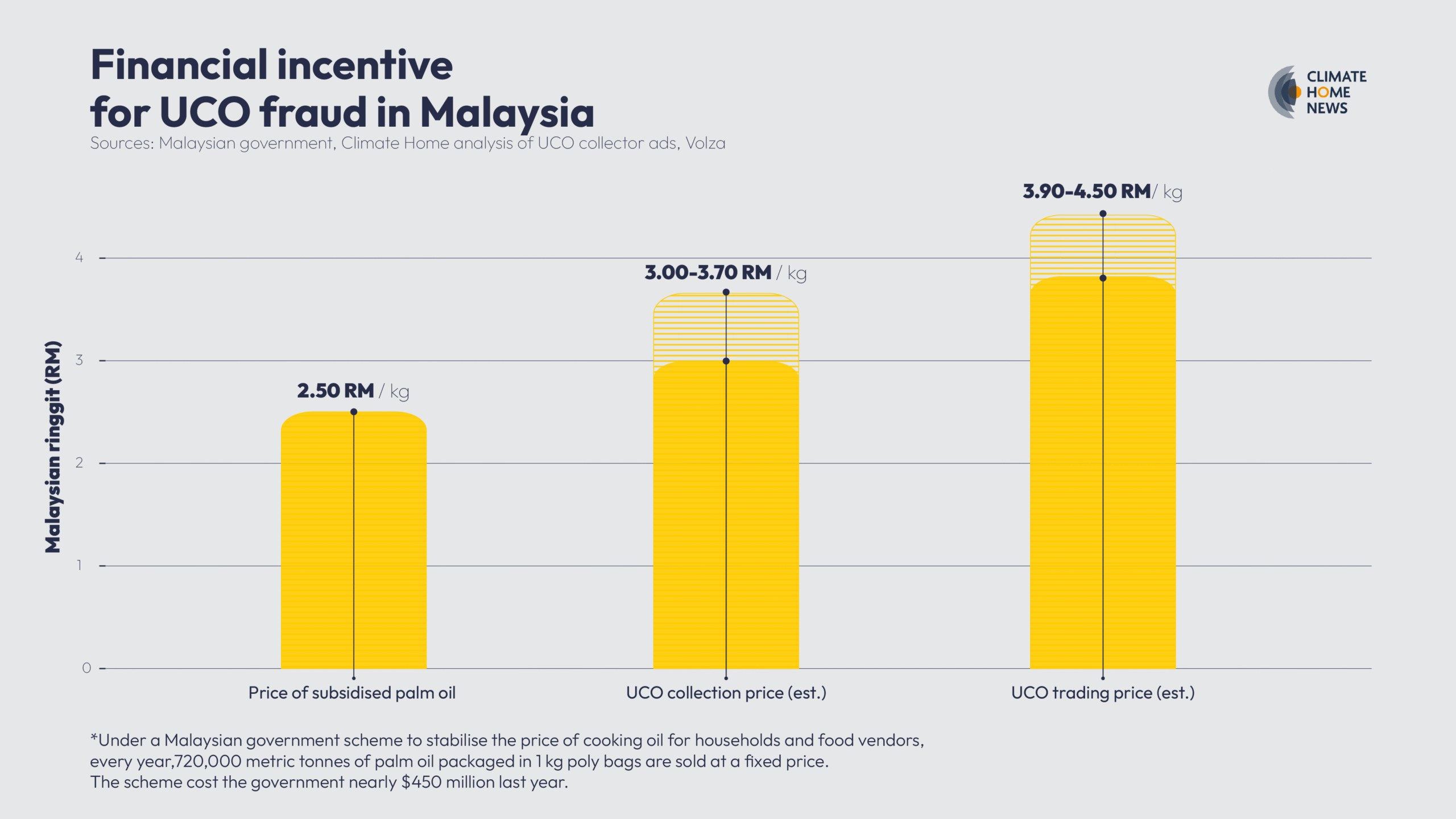

In a 2024 report, Brussels-based environmental group Transport & Environment (T&E) cited figures showing that Malaysia already exports about three times as much UCO as it is estimated to collect domestically and import, raising concern about where that oil is coming from – and what it consists of.
The analysis by consultancy Stratas Advisors, used as a basis for the report, says the “substantial deficit” indicates the “risks of fraud and palm oil potentially compensating for the shortfall”.
In 2023, 458,000 tonnes of UCO originating in Malaysia were registered with International Sustainability and Carbon Certification (ISCC), the leading certification scheme recognised by the European Commission to demonstrate compliance with its biofuels sustainability criteria.
In absolute terms, that puts Malaysia second only to China. But if all that UCO were collected from its population, it would have had by far the highest volumes per person worldwide: 15.2 litres for each Malaysian inhabitant, compared with 0.9 litres per capita in neighbouring Indonesia and 3.8 litres in Spain.
Cian Delaney, campaigns coordinator at T&E, said that figure is “ridiculous”, adding that for it to be feasible, Malaysia would need to be “a world leading collection and refining system – which it isn’t”.
Exactly what it says on the bottle?
The waste ingredients from which SAF is made change hands multiple times in a largely opaque system. To verify their sustainability, European regulators rely on checks by private auditors and agencies that issue green certificates based on their findings.
But there is a blind spot: the restaurants, street stalls, households and factories from which the UCO is pooled self-declare the origin and authenticity of their contributions. Aside from ad-hoc spot checks and sampling, there is no way of knowing that all of these providers are telling the truth.
“The opportunity, or incidents, of fraud is very high,” said Vasu R Vasuthewan, the former Malaysia head for the ISCC.
Malaysian authorities recently uncovered criminal syndicates that had pocketed thousands of dollars a day by getting hold of large amounts of subsidised cooking oil, mixing it in with UCO, and then selling it on to industrial UCO traders.


Industry sources told Climate Home and The Straits Times that many households and restaurants are motivated to replace cooking oil after a single use – contrary to standard practice – and then sell it on as UCO. Cooking oil is considered waste when it is no longer fit for frying – generally after being used between three and five times.
“Restaurant compliance [with sustainability standards] may be very low,” said Vasuthewan, who now runs his own UCO import and export business. “Many will fake their declaration, hoping they won’t get caught.”
Malaysia’s Deputy Minister of Plantation and Commodities Chan Foong Hin, who has acknowledged that fraud is an issue in the UCO sector, said authorities are “actively monitoring the industry to prevent fraudulent activities” and strengthening enforcement mechanisms.
“To maintain supply chain integrity, various measures are in place, including traceability systems, certification requirements, and stringent export documentation,” he told The Straits Times.
Delaney of T&E said it is difficult for auditors to physically check the origin of the oil, since hundreds of restaurants can supply the same collection point, making it a “notable blind spot”.
Spot checks, patchy audits
In theory, there is a system in place to keep fraudulent stocks out of the supply chain. Buyers and regulators in Europe rely on audit companies to trace the raw materials used in SAF and prove their green credentials.
Those audits are verified by authorised certification systems like ISCC – which is led by the biofuels industry and, according to one source, enjoys “a kind of monopoly” in the sector. It then issues sustainability certificates to commodities traders and fuel suppliers.
ISCC says its certification process supports “sustainable, fully traceable, deforestation-free and climate-friendly supply chains”.
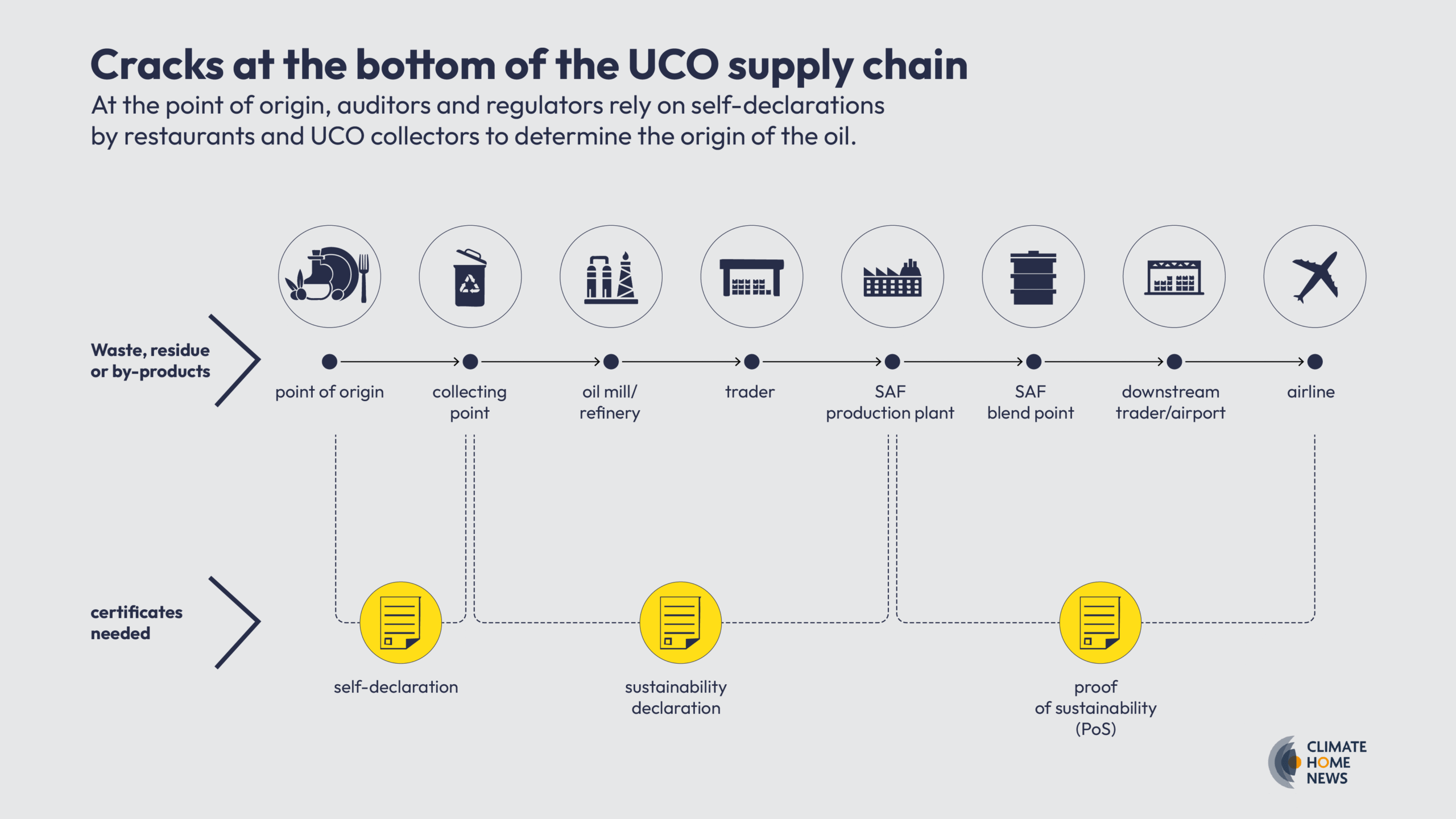

Yet while auditors conduct random field checks in some cases, that happens less often in countries outside the EU, industry experts say.
According to James Cogan, compliance and markets lead at Irish biofuel firm Clonbio, it is far easier for fraud to occur outside the EU where “it’s much less visible to us”.
An analysis by T&E in China, for example, showed that sampling of points of origin happened in less than 10% of the ISCC-approved audits, whereas in the EU it was about 30%.
Adam Kirby, ISCC’s senior sustainability manager, told Climate Home that auditors monitor volumes coming in and out of collection points for any suspicious behaviour, in addition to carrying out spot checks.
He added that the ISCC follows the requirements established by regulators like the European Commission.
-
Factbox: How ISCC verification works
Throughout the complex SAF supply chain, the ISCC requires operators to pass certified information on the origin of the raw materials and their carbon savings from one operator to another.
Traders typically receive UCO from individuals and restaurants at collection points or storage facilities audited under the scheme. But those bringing in the oil are mostly not vetted directly. In the majority of cases, they are simply required to fill out a self-declaration form stating that their UCO meets the definition of waste, meaning that it is not just regular palm oil, and is compliant with the ISCC’s sustainability criteria.
UCO collectors are required to keep all these forms in a database available for inspection by third-party auditors who check that the same amount of UCO coming into a facility is then going out.
If everything stacks up, the ISCC issues a “proof of sustainability” certificate which fuel producers like Repsol rely on to confidently buy the raw material in compliance with EU and/or international regulations.
Airlines are given access to these certificates as evidence they are buying SAF that meets sustainability requirements
In 2024, ISCC also conducted 79 special “integrity assessments” – around two-thirds targeting Asia-based suppliers – which independently monitored the work of auditors. In a third of cases, it found violations of its certification requirements, including an inability to demonstrate the traceability of products, leading to the withdrawal of 11 certificates.
From frying pan to frequent flier
Under the current system, the entire SAF supply chain relies on a long paper trail rooted in those self-declarations and sporadic inspections at the points where UCO is collected.
In Malaysia, Evergreen’s owner CK Lau told The Straits Times the company follows the “proper processes” in its collection based on the requirements established by the ISCC. He added that the documentation is “critical” as, otherwise, the company would not be able to export its UCO.
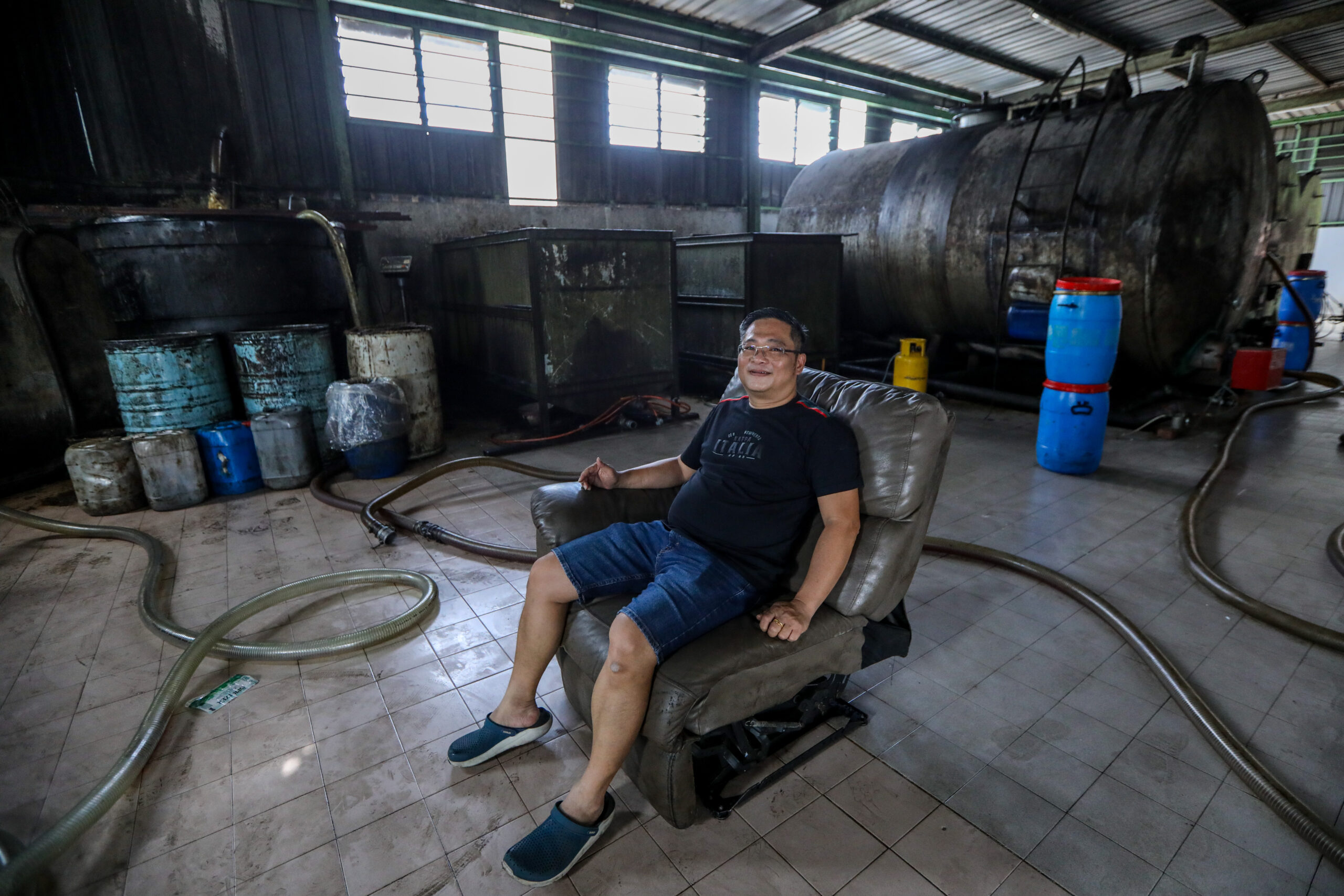

Repsol, for its part, said it requires “suppliers to be certified under European Commission-recognised voluntary regimes”.
In turn, airline companies that buy from Repsol such as International Airlines Group (IAG) – the parent company of British Airways, Iberia, Vueling, Aer Lingus and LEVEL – rely on documentation they get from it and other jet fuel providers, to show the SAF they are paying for has green certification.
In exceptional cases, IAG told Climate Home it has sent its own staff to carry out checks on the ground, as with a Shanghai-based Chinese supplier last year. It described the outcome of that audit – which included supply, record-keeping, environmental and health and safety standards – as “positive”.
Robert Boyd, Boeing’s Asia-Pacific sustainability lead who previously worked for IATA, thinks airlines’ exacting standards will bring positive change in the SAF industry. “You’ll see a race to the top… on sustainability, and it will, in a way, be self-regulated,” he added.
SAF certification faces EU scrutiny
In the meantime, following a string of fraud allegations about the authenticity of UCO-derived biofuels imported from China, the EU has been trying to ascertain whether the certification system governments and businesses rely on is fit for purpose.
EU authorities have been in talks to strengthen that system, leading to speculation that the ISCC could be suspended for failing to catch cases of biodiesel fraud. The ISCC denied in a statement that regulators had considered halting automatic EU-wide acceptance of its certificates, adding that its relationship with the European Commission remained constructive.
“There’s always bad actors, there’s always bad people, and there’s only a certain amount of policing that can be done in any industry,” said Kirby. “We at ISCC have done, I think, an incredible job.”
A European Commission spokeswoman said the bloc’s executive arm was “closely monitoring” the SAF market “to detect and prevent fraud, which risks undermining the EU’s ambition to effectively decarbonise air transport”.
Authorities in the US and Singapore, which wants to position itself as a regional SAF hub, have also voiced concern about fraud in the SAF supply chain.
“We are aware of concerns raised by various stakeholders, including the EU and the US, regarding fraudulent practices in the SAF supply chain. We share the same concerns as these pose risks to market confidence, fair trading and development of a nascent SAF market,” said Daniel Ng, chief sustainability officer at the Civil Aviation Authority of Singapore (CAAS).
He said the authority was working with the International Civil Aviation Organization’s Committee on Aviation Environmental Protection to develop “harmonised standards for feedstock verification to prevent further fraudulent practices”.
Demand for UCO sizzles
Whatever action regulators take to keep SAF fraud-free, leading European refiners such as Repsol are pushing for a level global playing field as well as more public funding to bring down costs and help develop the nascent sector on the continent.
IATA warned earlier this month that the European mandates had caused the SAF price paid by airlines to double because of hefty compliance fees being charged by producers.
Repsol’s aviation head Carlos Suárez Cubillo warned that fuel producers in parts of the world with laxer rules could produce SAF “with less regulation and less control of the feedstock… and here in Europe that could de-incentivise the production, the construction of new facilities”.
In Brazil, for example, an emerging SAF industry is gearing up to use crop-based feedstocks that are commonly linked to deforestation – and are therefore banned in Europe – such as soy and palm oil, as well as sugarcane-based ethanol, which has been linked to labour abuses and modern slavery.
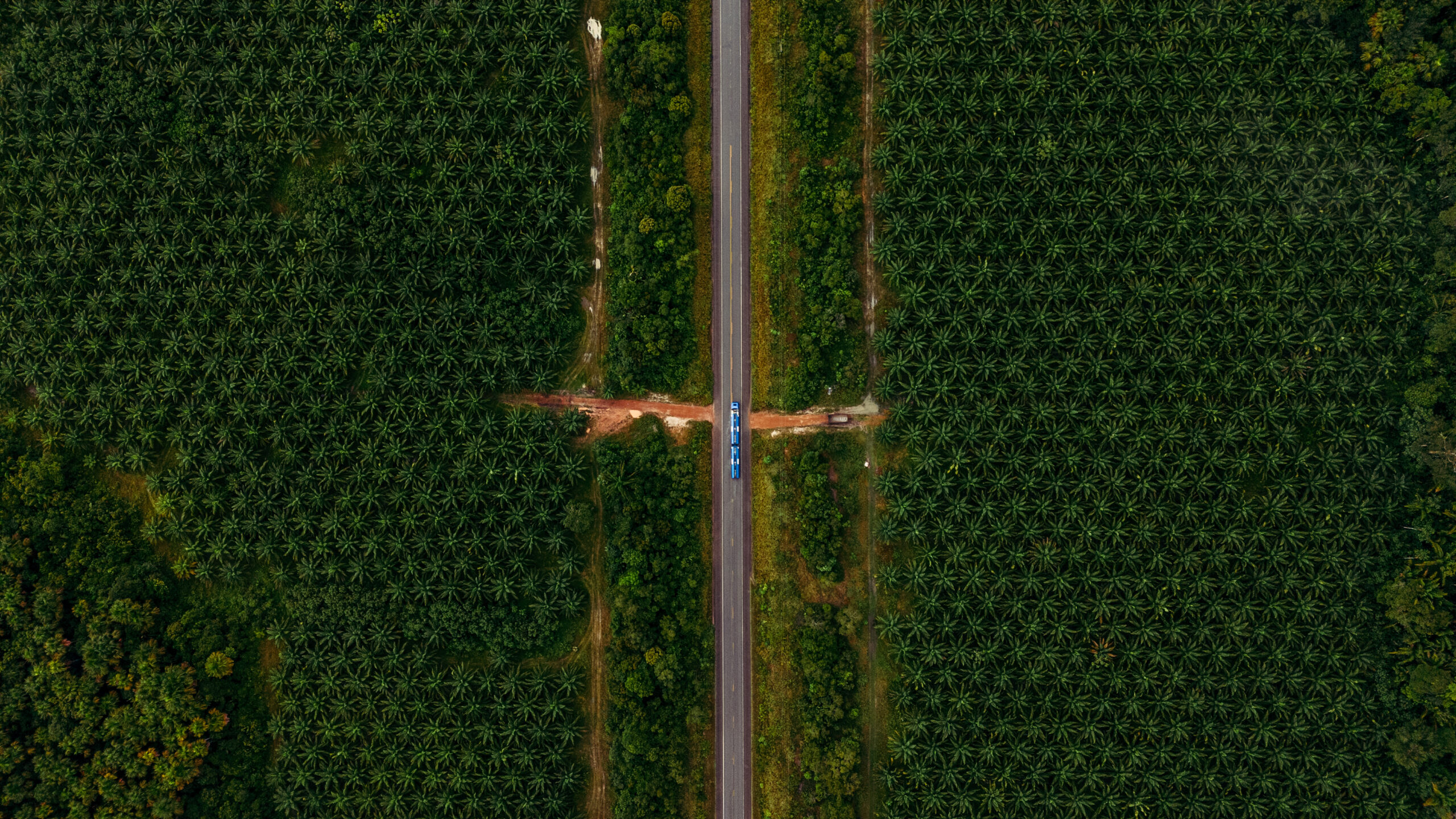

An investigation by Climate Home’s partner in Brazil, InfoAmazonia, found that the palm oil producer behind a planned biorefinery in the Amazon region – billed as Brazil’s first SAF project – is growing the crop on land areas subject to sanctions by the national environment agency over illegal deforestation, and is struggling financially after rights abuse allegations.
Brazilian firm behind SAF plan found growing oil palm on deforested Amazon land
IATA hopes its efforts to put in place a global registry for SAF, launched in April as a voluntary initiative, will boost transparency around feedstocks and their greenhouse gas savings – and enable airlines to have some level of visibility and comparability between countries, fuel providers and airports.
SAF producers and airlines are also looking to other waste-based materials to meet rising mandates – especially as more advanced fuels made from green hydrogen and carbon dioxide, known as e-SAF, are still being developed and tested.
Air travel’s ‘holy grail’: Jet fuel made from CO2 and water prepares for take-off
Repsol, for example, recently closed a deal with US vegetable oils giant Bunge to source camelina and safflower – non-food crops that can grow on poor land – to produce hydrotreated vegetable oil (HVO) for biodiesel and SAF.
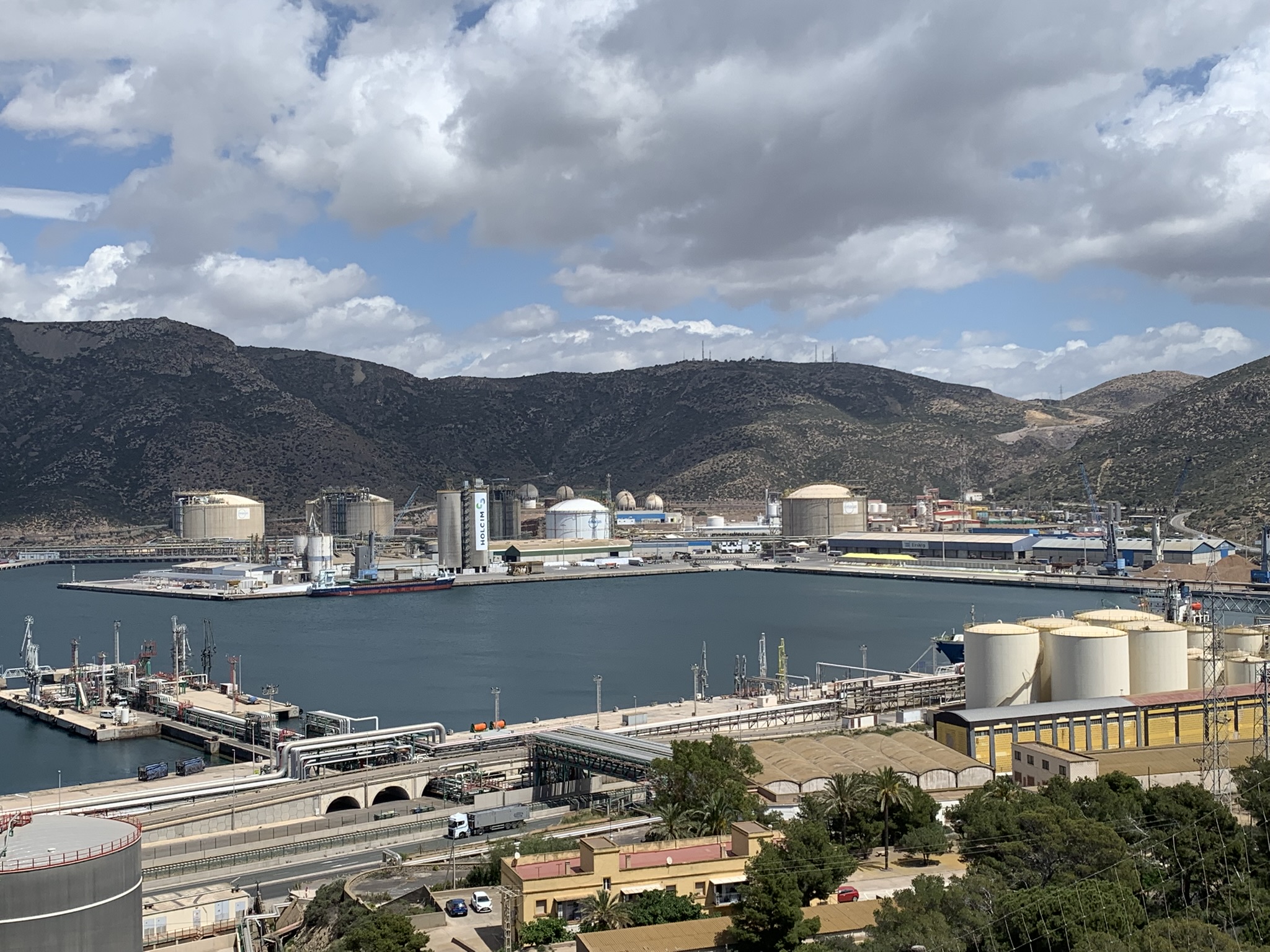

In January, it also announced it would invest more than 800 million euros ($906 million) in Europe’s first plant in the Catalan city of Tarragona to produce “renewable” methanol from organic urban waste that now ends up in landfill, for use in maritime, road and aviation transport from 2029.
But in the meantime, Europe’s overwhelming reliance on UCO means it will continue to import supplies from Asia – despite the concerns over fraud, said Sophie Byron, global head of biofuels pricing at S&P Global Commodity Insights.
“That trade flow is not going away anytime soon,” she said.
‘Token effort’ on aviation emissions?
At Repsol’s vast refinery complex near Cartagena, the colourful pipes and metal cylinders of the flagship SAF unit are dwarfed by the site’s traditional, fossil fuel-refining infrastructure.
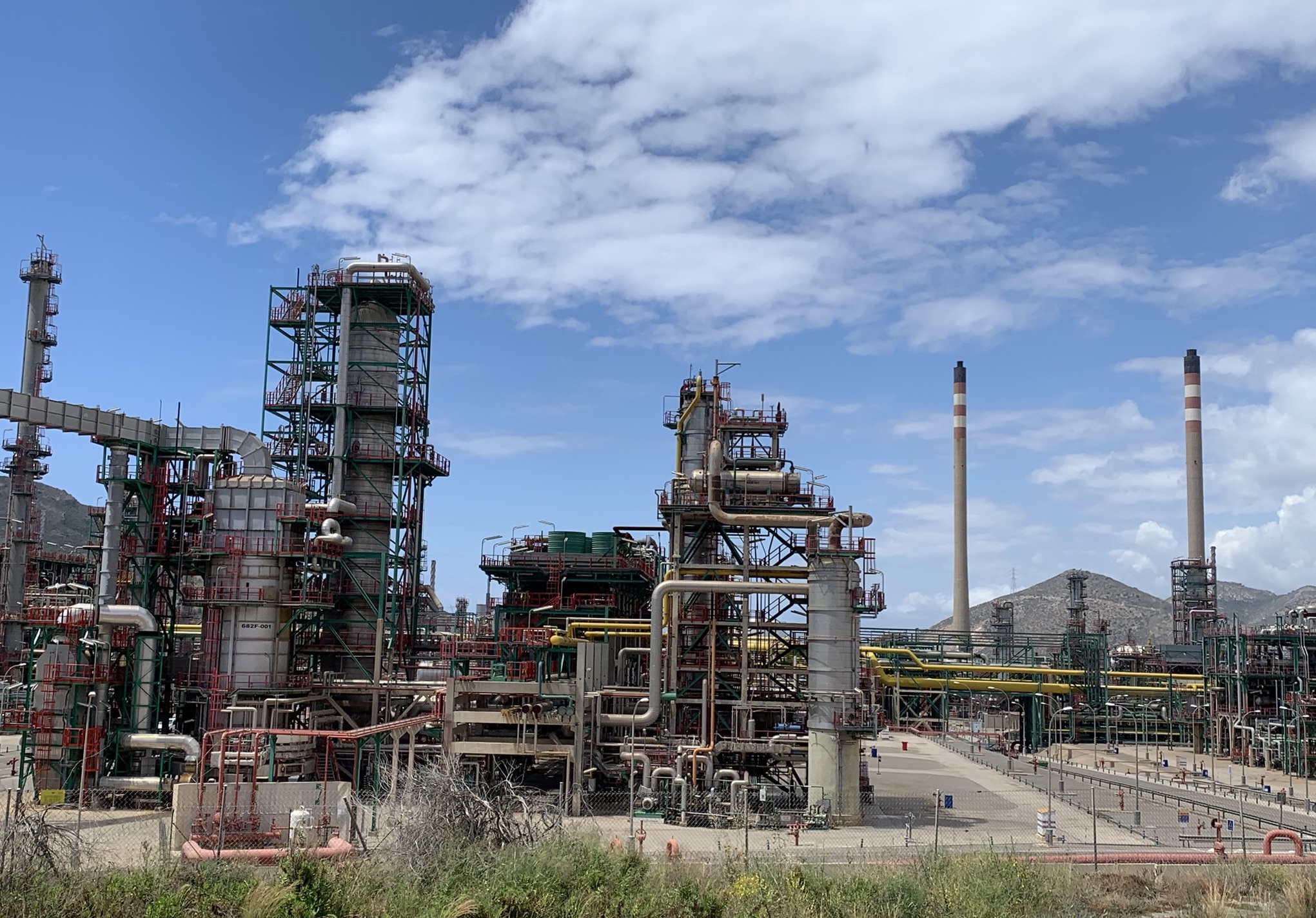

Repsol’s plants processed 43.3 million tonnes of crude oil last year, according to its annual report. In contrast, its renewable fuels production capacity stands at 1.25 million tonnes per year – of which the Cartagena plant accounts for 250,000 tonnes, including SAF.
It is a token effort towards tackling rising aviation emissions, said Pedro Luengo of Spanish environmental network Ecologistas en Acción, standing on a hillside overlooking the complex.
As Spain’s airports prepare for another record-breaking summer holiday influx this year, Luengo warned that the hype around SAF could prove counter-productive in the fight against climate change by justifying yet more air travel.
“Instead of gradually substituting fossil fuels with other [green] sources and consuming less, what we are doing is expanding the opportunities because we have more fuels available to use,” he said. “That is a contradiction.”
This investigation was developed with the support of Journalismfund Europe.
The Straits Times in Singapore will publish a version of this story in the coming days.
The post Is the world’s big idea for greener air travel a flight of fancy? appeared first on Climate Home News.
Is the world’s big idea for greener air travel a flight of fancy?
Climate Change
COP30 fails to land deal on fossil fuel shift but triples finance for climate adaptation
After all-night talks, governments at COP30 agreed on Saturday to launch limited initiatives to strengthen emissions-cutting plans, as well as tripling finance to help poor countries cope with worsening climate change impacts by 2035. But the Amazon summit’s outcomes fell short on the global transition away from oil, gas and coal.
In an effort to deliver something on fossil fuels, the Brazilian presidency complemented the final Belém package by promising to create roadmaps on transitioning away from fossil fuels and protecting forests – as requested by Brazilian President Lula da Silva.
Brazil tabled its roadmap proposal at the eleventh hour as a compromise solution after some nations – especially European and Latin American states – voiced disappointment that a formal deal was not reached on one after strong pushback from large fossil fuel producers led by Saudi Arabia.
Brazil’s roadmap process will sit outside the UN climate regime. It will be supported by other countries such as Colombia, which is organising the first global conference on the issue, said COP30 president André Aranha Corrêa do Lago. He added that he will also craft a second roadmap to halt and reverse deforestation and report back to the COP on them both.
“We know some of you had greater ambition for some of the issues at hand,” Corrêa do Lago told a closing plenary. “I will try not to disappoint you.”
After week-long row, COP30 fails to mention fossil fuels
After more than 80 countries called for a roadmap to phase down oil, coal and gas to be kickstarted at COP30, observers said fossil fuel heavyweights, including Gulf States, Russia and India, had insisted it stay out of the final Global Mutirão decision adopted in Belém, along with any explicit mention of fossil fuels.
On Friday, the European Union and the UK had fought hard against that opposition but ultimately had to settle for two new processes that are meant to reinforce ambition and implementation of countries’ national climate plans (NDCs), with reports and a high-level dialogue due next year.
Before the final plenary, EU Climate Commissioner Wopke Hoekstra said it had been “an intense and sometimes difficult week and evening”, adding “we would have liked to have more”. But, he said, “we think we should support [the COP outcome] because at least it is going in the right direction.”
The Mutirão text encourages countries ”to strengthen their existing nationally determined contribution at any time with a view to enhancing its level of ambition” and calls on them to accelerate their implementation “while striving to do better collectively and cooperatively”.
In a last-minute push, Colombia – which championed a declaration to transition away from oil, coal and gas – told the closing plenary the country was “left with no other choice” but to object to the outcome of the dedicated mitigation track on emission-cutting efforts unless a mention to fossil fuels was added. After the presidency tried to dismiss concerns, Colombia insisted and the plenary was suspended.
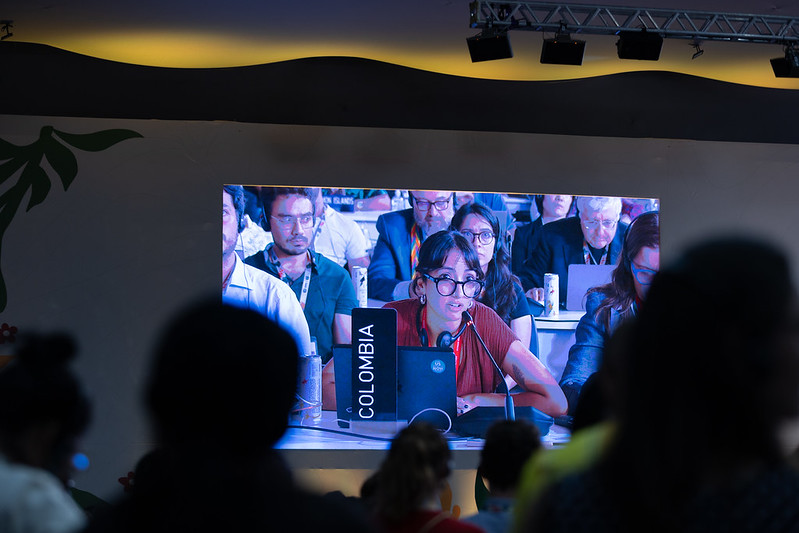

Developed countries – especially the EU – had felt isolated in their push for stronger language on emission-cutting measures after failing to win vocal support from traditional allies such as the Alliance of Small Island States (AOSIS) and the Least Developed Countries (LDCs).
That was mainly because of Europe’s inability to make a compelling offer on finance for adaptation, negotiators and observers said.
“Adaptation COP” triples finance for climate resilience
A demand from the world’s poorest nations to triple adaptation finance was agreed, but only by a deadline of 2035 rather than 2030, and without a clear number.
However, the main Mutirão decision urges developed countries to increase their collective provision of climate finance for adaptation to the Global South. It also sets up a two-year process on climate finance as well as a high-level ministerial roundtable to discuss progress towards meeting the new climate finance goal agreed last year at COP29.
That COP29 goal sets a target for rich nations to provide $300 billion a year for climate action by 2035 – and the tripling of adaptation finance decided in Belem will be part of this, as the EU had insisted.
“It is very clear that we should stand shoulder to shoulder with the poorest nations,” the EU’s climate chief Wopke Hoekstra said before the final conference session began.
Some African ministers gave the outcome on adaptation finance a cautious welcome. But many countries – including the EU, some Latin American states, Switzerland and Canada – were angry about a text that adopted indicators to measure progress on adaptation efforts.
They made interventions rejecting the decision on a new Global Goal on Adaptation (GGA) – expected to be a flagship outcome at this COP – which included a rewritten and shortened list of metrics to measure progress on climate resilience originally developed by technical experts.
Jiwoh Abdulai, environment minister of Sierra Leone, said they had worked tirelessly to craft a set of indicators that would reflect “lived realities” on the ground, but are now left with “unclear, unmeasurable and – in many cases – unusable” ones.
“For us, this is not technical, this is about our survival,” he added before the plenary was suspended.
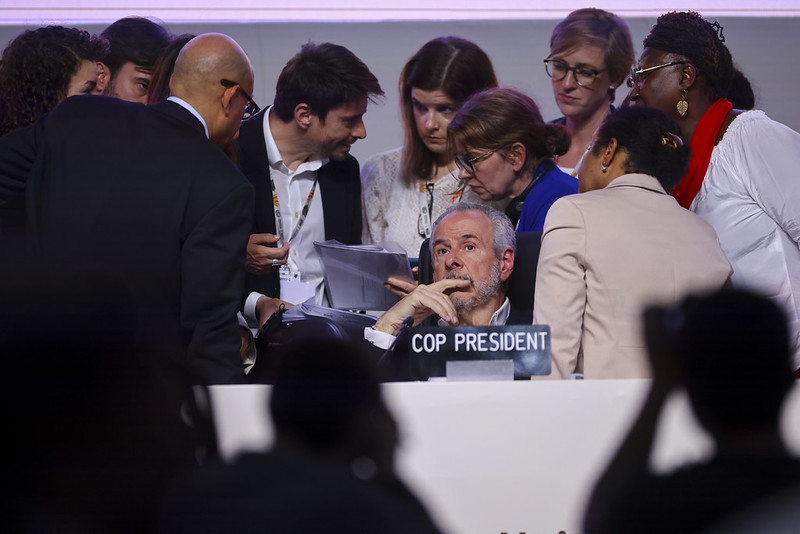

Trade and just transition land wins in Belém deal
As the Belem political package was adopted to muted applause from countries, campaigners at the back of the room whooped with joy as the conference approved a decision on just transition.
They and developing countries had swung behind a new “Belém Action Mechanism”, intended to serve as a hub to support countries in taking concrete steps to ensure their shift from dirty to clean energy systems is fair and equitable.
The Mutirão decision also includes trade, another key issue that was not on the official negotiating agenda, along with long-term climate finance and the gap in emissions-cutting ambition.
Annual dialogues will take place at the next three mid-year Bonn sessions on boosting international cooperation on trade – an emerging economy priority in the context of a carbon levy on imports proposed by the EU.
Experts said the inclusion of trade in a COP decision was a big win for China. “For the first time, trade is elevated alongside mitigation and finance as a critical third pillar for climate progress,” said Kate Logan, director of China Climate Hub at the Asia Society Policy Institute, adding that this “is likely to remain a key arena for China’s influence” in the climate regime.
The decision reaffirms that “measures taken to combat climate change, including unilateral ones, should not constitute a means of arbitrary or unjustifiable discrimination or a disguised restriction on international trade”.
The post COP30 fails to land deal on fossil fuel shift but triples finance for climate adaptation appeared first on Climate Home News.
https://www.climatechangenews.com/2025/11/22/cop30-brazil-deal-fossil-fuel-transition-fails-triples-finance-climate-adaptation/
Climate Change
COP30 fails to land deal on fossil fuel transition but triples finance for climate adaptation
After all-night talks, governments at COP30 agreed on Saturday to launch limited initiatives to strengthen emissions-cutting plans, as well as tripling finance to help poor countries cope with worsening climate change impacts by 2035. But the Amazon summit’s outcomes fell short on the global transition away from oil, gas and coal.
In an effort to deliver something on fossil fuels, the Brazilian presidency complemented the final Belém package by promising to create roadmaps on transitioning away from fossil fuels and protecting forests – as requested by Brazilian President Lula da Silva.
Brazil tabled its roadmap proposal at the eleventh hour as a compromise solution after some nations – especially European and Latin American states – voiced disappointment that a formal deal was not reached on one after strong pushback from large fossil fuel producers led by Saudi Arabia.
Brazil’s roadmap process will sit outside the UN climate regime. It will be supported by other countries such as Colombia, which is organising the first global conference on the issue, said COP30 president André Aranha Corrêa do Lago. He added that he will also craft a second roadmap to halt and reverse deforestation and report back to the COP on them both.
“We know some of you had greater ambition for some of the issues at hand,” Corrêa do Lago told a closing plenary. “I will try not to disappoint you.”
After week-long row, COP30 fails to mention fossil fuels
After more than 80 countries called for a roadmap to phase down oil, coal and gas to be kickstarted at COP30, observers said fossil fuel heavyweights, including Gulf States, Russia and India, had insisted it stay out of the final Global Mutirão decision adopted in Belém, along with any explicit mention of fossil fuels.
On Friday, the European Union and the UK had fought hard against that opposition but ultimately had to settle for two new processes that are meant to reinforce ambition and implementation of countries’ national climate plans (NDCs), with reports and a high-level dialogue due next year.
Before the final plenary, EU Climate Commissioner Wopke Hoekstra said it had been “an intense and sometimes difficult week and evening”, adding “we would have liked to have more”. But, he said, “we think we should support [the COP outcome] because at least it is going in the right direction.”
The Mutirão text encourages countries ”to strengthen their existing nationally determined contribution at any time with a view to enhancing its level of ambition” and calls on them to accelerate their implementation “while striving to do better collectively and cooperatively”.
In a last-minute push, Colombia – which championed a declaration to transition away from oil, coal and gas – told the closing plenary the country was “left with no other choice” but to object to the outcome of the dedicated mitigation track on emission-cutting efforts unless a mention to fossil fuels was added. After the presidency tried to dismiss concerns, Colombia insisted and the plenary was suspended.
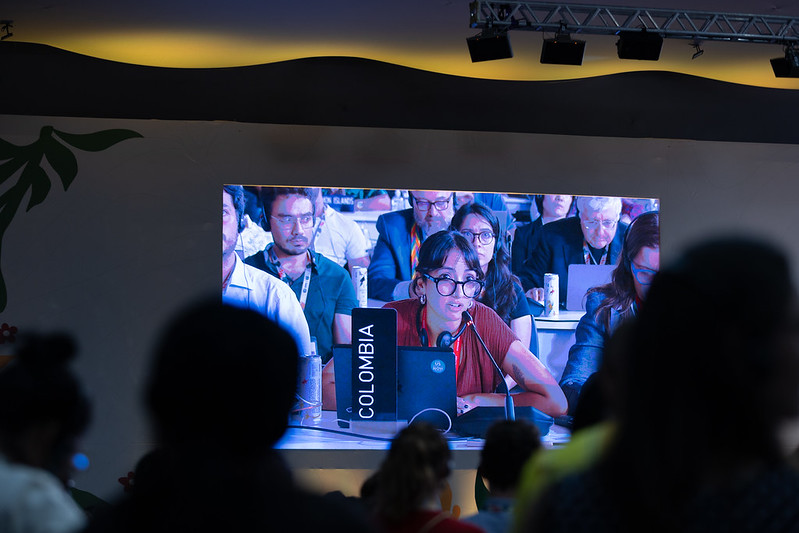

Developed countries – especially the EU – had felt isolated in their push for stronger language on emission-cutting measures after failing to win vocal support from traditional allies such as the Alliance of Small Island States (AOSIS) and the Least Developed Countries (LDCs).
That was mainly because of Europe’s inability to make a compelling offer on finance for adaptation, negotiators and observers said.
“Adaptation COP” triples finance for climate resilience
A demand from the world’s poorest nations to triple adaptation finance was agreed, but only by a deadline of 2035 rather than 2030, and without a clear number.
However, the main Mutirão decision urges developed countries to increase their collective provision of climate finance for adaptation to the Global South. It also sets up a two-year process on climate finance as well as a high-level ministerial roundtable to discuss progress towards meeting the new climate finance goal agreed last year at COP29.
That COP29 goal sets a target for rich nations to provide $300 billion a year for climate action by 2035 – and the tripling of adaptation finance decided in Belem will be part of this, as the EU had insisted.
“It is very clear that we should stand shoulder to shoulder with the poorest nations,” the EU’s climate chief Wopke Hoekstra said before the final conference session began.
Poorest countries appeal for more adaptation finance at COP30
Some African ministers gave the outcome on adaptation finance a cautious welcome. But many countries – including the EU, some Latin American states, Switzerland and Canada – were angry about a text that adopted indicators to measure progress on adaptation efforts.
They made interventions rejecting the decision on a new Global Goal on Adaptation (GGA) – expected to be a flagship outcome at this COP – which included a rewritten and shortened list of metrics to measure progress on climate resilience originally developed by technical experts.
Jiwoh Abdulai, environment minister of Sierra Leone, said they had worked tirelessly to craft a set of indicators that would reflect “lived realities” on the ground, but are now left with “unclear, unmeasurable and – in many cases – unusable” ones.
“For us, this is not technical, this is about our survival,” he added before the plenary was suspended.
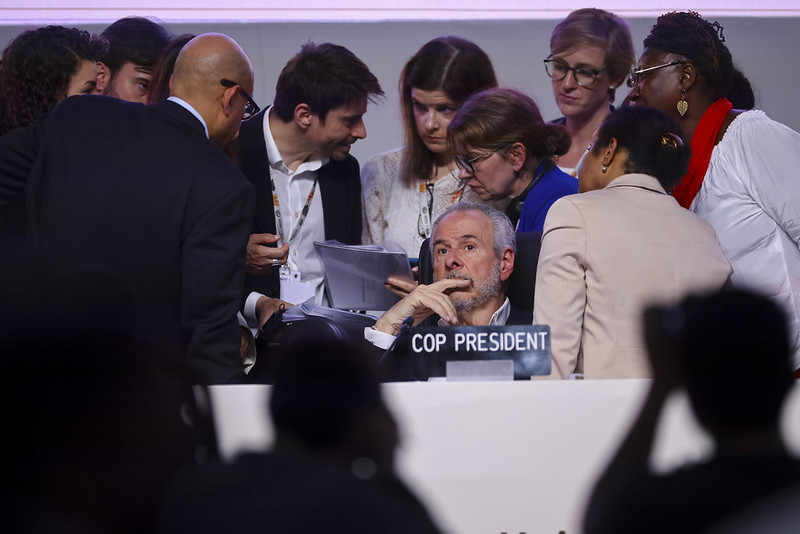

Trade and just transition land wins in Belém deal
As the Belem political package was adopted to muted applause from countries, campaigners at the back of the room whooped with joy as the conference approved a decision on just transition.
They and developing countries had swung behind a new “Belém Action Mechanism”, intended to serve as a hub to support countries in taking concrete steps to ensure their shift from dirty to clean energy systems is fair and equitable.
The Mutirão decision also includes trade, another key issue that was not on the official negotiating agenda, along with long-term climate finance and the gap in emissions-cutting ambition.
Annual dialogues will take place at the next three mid-year Bonn sessions on boosting international cooperation on trade – an emerging economy priority in the context of a carbon levy on imports proposed by the EU.
Experts said the inclusion of trade in a COP decision was a big win for China. “For the first time, trade is elevated alongside mitigation and finance as a critical third pillar for climate progress,” said Kate Logan, director of China Climate Hub at the Asia Society Policy Institute, adding that this “is likely to remain a key arena for China’s influence” in the climate regime.
The decision reaffirms that “measures taken to combat climate change, including unilateral ones, should not constitute a means of arbitrary or unjustifiable discrimination or a disguised restriction on international trade”.
The post COP30 fails to land deal on fossil fuel transition but triples finance for climate adaptation appeared first on Climate Home News.
COP30 fails to land deal on fossil fuel transition but triples finance for climate adaptation
Climate Change
Your Summary of Negotiations: Nov. 22
There’s been a lot of chatter about Roadmaps in Belem. The WWF and Greenpeace have led a call for a roadmap to end deforestation. Currently, 45 countries have indicated support. More than 80 countries have called for a roadmap to phase out fossil fuels. Additionally, there are four other roadmaps on finance from developed to developing countries. Climate Action Network wonders, “Roadmap or mazes? Will those lead us somewhere, or will we be even more lost with so many of them?!”
Brazil’s TFFF plan has raised $5.5bn — far below even Brazil’s reduced target of $10bn by next year. Norway, Brazil, Indonesia, Portugal, France, and the Netherlands have all committed to pay into the fund, while Germany has said it will announce its contribution soon. The UK and China, on the other hand, do not plan to pay in.
Away from COP30 negotiations, talks continued over the COP31 host, with Türkiye and Australia striking a compromise: Türkiye will host the conference, and Australia’s climate change and energy Minister, Chris Bowen, as COP president, will chair the talks.
UN Secretary General, António Guterres, returned to Belém on Thursday to urge the world’s nations to find compromises in the final hours of COP30 and deliver a deal to accelerate climate action: “We are down to the wire and the world is watching… The world must pursue a just, orderly, and equitable transition away from fossil fuels.”
On Tuesday, COP30 hosts Brazil produced a first draft of an agreement between nations at the UN climate talks after negotiations on the sticking points stretched late into the night. The nine-page “Global Mutirao” document – a reference to an Indigenous concept of uniting toward a common goal – came after Brazil on Monday urged delegates to work day and night to produce an agreement by midweek.
Over the next few days, negotiations intensified. On Friday morning, the Presidency published its new mutirão text that contains no mention of a phase-out of fossil fuels. At least 29 nations threatened to block any draft without this phase-out and then rejected the text. The letter states, “We cannot support an outcome that does not include a roadmap [on fossil fuels].” Countries that signed the letter in favor of the fossil fuel phase-out include: Austria, Belgium, Chile, Colombia, Costa Rica, Croatia, Czechia, Estonia, Finland, France, Germany, Guatemala, Honduras, Iceland, Ireland, Liechtenstein, Luxembourg, the Marshall Islands, Mexico, Monaco, the Netherlands, Panama, Palau, Slovenia, Spain, Sweden, Switzerland, the UK and Vanuatu. Another bloc of around 80 countries, that includes Saudi Arabia, Russia and some other petrostates, as well as some countries dependent on consuming fossil fuels is negotiating against the fossil fuel phase out roadmap.
Colombia and the Netherlands also announced that they will co-host the First International Conference on the Just Transition Away from Fossil Fuels in Santa Marta, Colombia, in April next year.
The climate talks are now likely to continue into the weekend. The European Union’s commissioner for climate, Wopke Hoekstra, warned there was a risk of no agreement being reached, and expressed dismay at the current text saying there was no science, no mention of a transition for fossil fuels, no global stocktake.
No UN climate conference has finished on time since 2003.

Aside from the fossil fuel debate, other issues also remain to be resolved, including a response to the fact that countries’ national climate plans are too weak to limit global heating to 1.5C above preindustrial levels as set out in the 2015 Paris agreement, and questions of finance, trade and transparency, and how much cash developing countries will receive to help them adapt to the impacts of the climate crisis.
The issue of gender has become contentious and has been lifted by the COP30 Presidency from technical negotiations to a higher political level with ministers. Conservative nations — from the Vatican to Iran — are pushing to narrow the definition of gender at COP30 to exclude trans and non-binary people, which threatens to increase the difficulty of already torturous negotiations. The effort uses footnotes in key texts to attach country-specific interpretations. Paraguay, Argentina, Iran, Indonesia, Malaysia, as well as the Vatican have so far entered footnotes into the draft Gender Action Plan (GAP) meant to guide work for the next decade. Similar footnotes have also appeared in a text related to the “just transition” — the framework to shift to environmentally sustainable economies without leaving workers and communities behind.
Outside the negotiating rooms, civil society groups have complained about the “militarization” of the COP30 venue, which is now guarded by heavily armed officers in riot gear following UNFCCC chief Simon Stiell’s complaints earlier. Indigenous activists say they feel particularly targeted.
The Global Afro Descendants Climate Justice Collaborative is calling for Afro-Descendant peoples to be recognized as a formal constituency within the UNFCCC. Their petition states, “For generations, Afro-Descendant and African communities have been at the heart of global struggles for equity, justice, and renewal. We are the descendants of those who cultivated, resisted, and rebuilt. We have carried the wisdom of sustainable living, the memory of displacement, and the spirit of resilience that continues to sustain our planet.” Read the full letter here. Meanwhile, the European Union, the United Kingdom, and Australia are explicitly opposing the inclusion of references to people of African descent in the Gender Action Plan, acting to silence and delegitimize legitimate and historically grounded demands.
“Simple message about COP30,” said Dr. Sam Grant, “This is a place of virulent anti-blackness.”
While a formal constituency is yet to be established, the Global Afrodescendant Climate Justice Collaborative announced Friday that for the first time, people of African descent appear in UNFCCC COP decisions and are referenced across multiple strands of negotiating texts. The texts are not finalized. “Nonetheless we are calling it a win to have people of African descent in the draft decisions,” said Mariama Williams of the GACJC.
Youth activists, more than 30,000 young people from over 100 countries, held a series of Youth-Led Forums and outlined calls for “full, fast, fair fossil phase-out,” institutionalizing intergenerational equity, moves toward peace, climate finance centered on justice, and adaptation “as a moral and political priority”.
The People’s Plenary was scheduled on Thursday, a space where civil society at COP comes together to make clear what their expectations and demands are of the negotiations, as we near the close. But a fire broke out in the Blue Zone, and the venue was evacuated. The fire has been contained with limited damage, and no serious injuries have been reported. Hosts report the fire was electrical.
There are more than 300 industrial agriculture lobbyists at COP30. According to DeSmog, the number of lobbyists representing the interests of industrial cattle farming, commodity grains, and pesticides is up 14 percent over last year’s summit in Baku — and is larger than the delegation of the world’s 10th largest economy, Canada, which brought 220 delegates to COP30 in Belém. Agriculture is responsible for 25 – 30% of global emissions.
We will continue to follow negotiations and hope to share the final agreements in our final window into COP30 Digest, scheduled to be released on December 3. Stay tuned.
Photo credit: Kiara Worth
The post Your Summary of Negotiations: Nov. 22 appeared first on Climate Generation.
-
Climate Change3 months ago
Guest post: Why China is still building new coal – and when it might stop
-
Greenhouse Gases3 months ago
Guest post: Why China is still building new coal – and when it might stop
-
Climate Change2 years ago
Spanish-language misinformation on renewable energy spreads online, report shows
-

 Greenhouse Gases1 year ago
Greenhouse Gases1 year ago嘉宾来稿:满足中国增长的用电需求 光伏加储能“比新建煤电更实惠”
-
Climate Change Videos2 years ago
The toxic gas flares fuelling Nigeria’s climate change – BBC News
-

 Climate Change1 year ago
Climate Change1 year ago嘉宾来稿:满足中国增长的用电需求 光伏加储能“比新建煤电更实惠”
-

 Carbon Footprint2 years ago
Carbon Footprint2 years agoUS SEC’s Climate Disclosure Rules Spur Renewed Interest in Carbon Credits
-
Renewable Energy4 months ago
US Grid Strain, Possible Allete Sale



